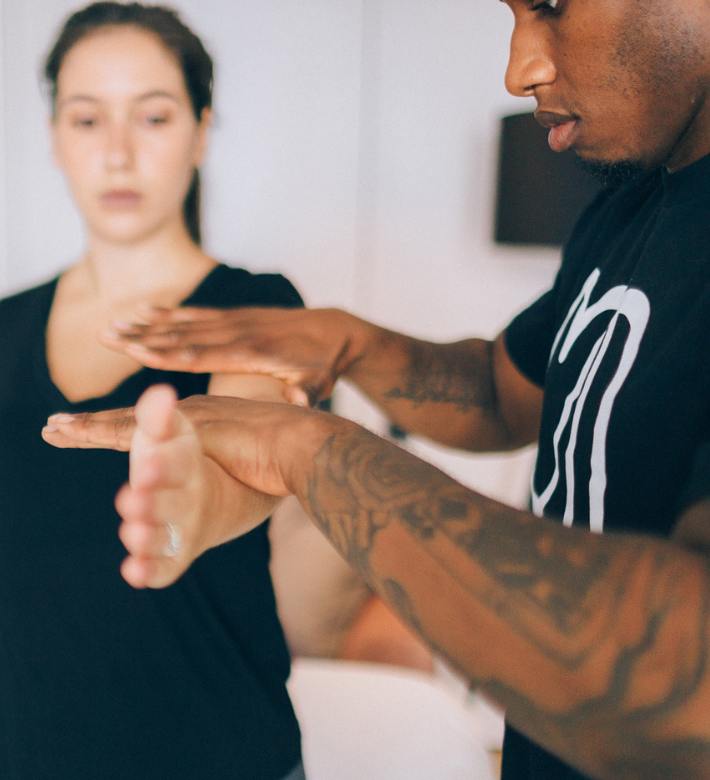Physiotherapy and osteopathy – what’s the difference?
About this post
Same, same. But different. Here’s the low-down on the subtle differences between osteopathy and physiotherapy.
Posted by
Tom at UrbanTags
- Health conditions
- Physiotherapy
- Wellbeing
- Treatment guides
Book a treatment at home
Share
When you’re in pain, you’ll do (and google) anything to feel better again. Whether it’s a specific ache that won’t go away, or a lingering sense that things aren’t right, physiotherapy and osteopathy can help. But which is right for you?
Osteopaths and physiotherapists are both mechanics for your body. They’re experts on muscles and bones. They’re highly trained. And they both work to boost your mobility and ease pain. But there are some important differences between the practices that are worth noting.

Prehab vs rehab
In general, physiotherapists tend to focus on rehabilitation, whereas osteopaths focus on maintenance or ‘prehab’. It’s a bit of a grey area, however, as both are trained in recovery and maintenance, and can adapt to what you need.
When should I see an osteopath?
There’s a feeling you get after a particularly hectic spell of city life – maybe you’ve been slouched at your desk for too long or your stride’s slightly off. It’s a craving for freedom of movement. A desire to rid yourself of lingering aches and pains and recapture that time when walking down the street and reaching for things on shelves felt effortless.
An osteopath can help with that. Their approach isn’t necessarily about treating specific areas, it’s about realignment. It’s holistic – they’ll look at the big picture, examining your posture, your range of motion, and your lifestyle to find the root cause of issues. Alongside treatment, they’ll give you some solid advice and a routine to follow to stop those issues turning into something more serious.
Typically, people see an osteopath for:
Lower back pain
Arthritis
Shoulder pain
Uncomplicated neck pain
Muscle and joint pain from driving or work
What does osteopathy involve?
In first appointments, osteopaths carry out detailed consultations before administering any treatment. Being assessed by an osteopath is as much an exploration of your daily routine as a checkup on your physical form, so they’ll ask questions about your lifestyle and day-to-day levels of activity. Then they’ll check your posture and range of motion.
To treat their patients, osteopaths use manual stretching and manipulation to move bones back into alignment. The process isn’t painful, but your practitioner may need to move your body in ways it isn’t used to. You may feel slightly sore for a few days after your treatment as your form adapts to the changes.
It’s worth noting that osteopaths sometimes treat unexpected areas which seem separate from specific aches and pains. That’s because they’re working on treating the root problem of your issues, which might be elsewhere on the body.
When should I see a physiotherapist?
After an injury or illness, physiotherapy is a key part of the recovery process. There’s a good reason for that. Where an osteopath works to realign your entire form, physiotherapists are more precise, zeroing in on specific parts of the body that have been weakened by injury or illness and boosting their strength and mobility.
Typically, people see physiotherapists to treat
Sporting injuries
Musculoskeletal (MSK) injuries
Chronic back and neck pain
And they can also specialise in:
Issues with movement related to
the brain and nerves
Cardiovascular issues, such as rehabilitation after a heart attack
Issues with the respiratory system
Pre- and post- natal care
Physiotherapy can also be preparatory, focusing on strengthening particular muscle groups and easing joint pain ahead of sporting events and operations.
How do physiotherapists treat their patients?
Physiotherapy sessions also start with an assessment of your physical condition, checking up on on the strength and range of motion of problem areas.
Physios also use manual treatment, normally consisting of stretching and manipulation of joints. Another key component of physio treatment is exercise.
Some physiotherapists have their own specialist skillsets, and can offer more specific treatments depending on their training.
Trigger point therapy
Dry needling
Kinesiology taping
And more.
Your physio will leave you with an understanding of the causes of discomfort and a plan for recovery – this typically includes a routine of daily stretches and exercises, recommendations on further treatments and a timeline for improvements.
Conclusion
Although they’re similar in many respects, there are some clear differences between osteopathy and physiotherapy. Let’s try to sum them up as neatly as possible:
Osteopathy takes a holistic approach, treating the body as a whole and looking for the root of the issue. Physiotherapy is more targeted, zeroing in on problem areas.
Osteopathy is preventative – it aims to avoid potential issues by making small changes to your lifestyle. Physiotherapy is all about recovery and rehabilitation for areas already weakened by injury or illness.
Osteopathy treatment is mostly manipulation of the body to bring it back into alignment. Physiotherapy is more active and exercise-focused, to build up strength and range of motion.
Book a specialist for appointments at home
With Urban, you can book mobile osteopathy and physiotherapy to your home - without a referral from your GP. Skip the waiting lists and get help in the comfort of home.
When you book with Urban, your pro can help guide you through the best times to book a massage. You’ll learn how massage therapy can optimise your body for the marathon, working with you right through to post-training recovery.
With Urban, you can book mobile osteopathy and physiotherapy to your home - without a referral from your GP. Skip the waiting lists and get help in the comfort of home.
Make life easier